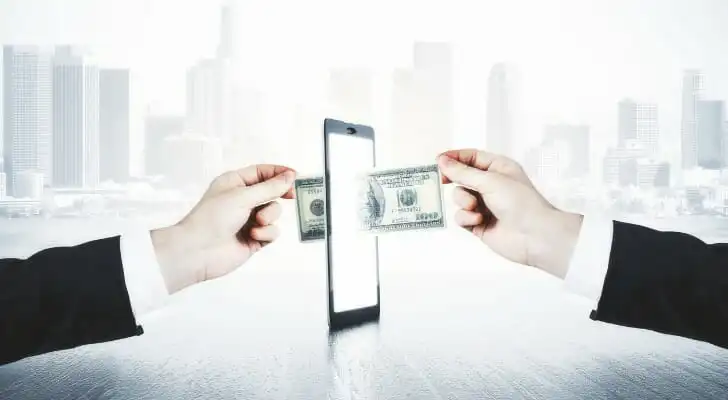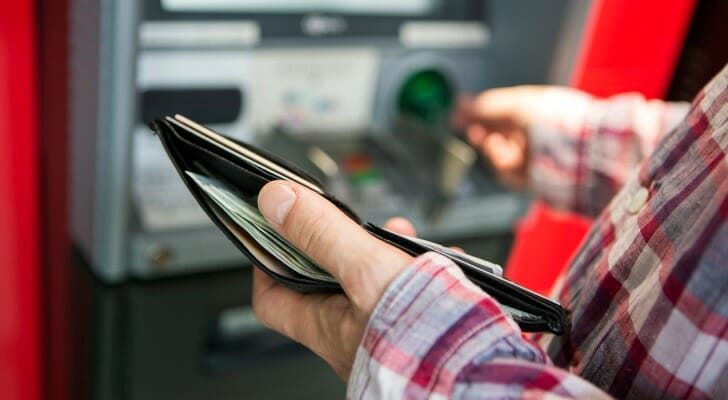If you are trying to send money to someone, you may consider just transferring funds to the person’s bank account. However, not everyone has a bank account. In fact, a 2024 FDIC survey revealed that 5.6 million households fall into that category. The good news is you have plenty of options to transfer money even without a bank account.
Do you have questions about managing your money? Consider speaking with a financial advisor today.
1. Money Order
Money orders work a bit like checks, but they are not linked to any bank account. Instead, you buy one in the amount you plan to send to someone. Then, you sign it and mail to the proper recipient, who can then exchange it for cash. Money orders are sold at Walmart and CVS, as well as any post office and many grocery stores and gas stations. They usually cost around $1 to $5, depending on where you get it from.
Money orders can be cheap and safe alternatives to mailing actual cash. Because you get an actual receipt for the money order, you have a paper trail to account for the money you are sending. Plus, you avoid the potential dangers of having your cash lost in the mail or stolen. In addition, you can cancel a money order in most cases as long as the recipient has not cashed it yet.
2. Zelle
Established in 2017, Zelle is a popular alternative to PayPal and Venmo. Instead of keeping a platform-specific wallet, you can use the bank account you already have to send and receive money. Money is deposited right into your bank account, with compatibility across thousands of banks like PNC Bank, Navy Federal Credit Union and Morgan Stanley. It’s also a fee-free platform, although your bank may charge some fees on its end.
3. Cash App
Cash App is a multi-faceted financial platform, allowing you to bank with the added opportunity of the Cash App Card. You can easily send money using your friend or family member’s phone number, email or $cashtag. They also have a personalized QR code you can scan to send funds directly. However, Cash App goes one step further, letting you send and receive stocks and bitcoin as currency.
It is free to receive money to a personal Cash App account, and there is no charge to send money from your CashApp balance or linked debit card. However, there is a 3% fee if you choose to send money to a credit card. Cashing out is free, but there is a fee of up to 1.75% for expedited transfers.
4. PayPal
When it comes to online money transferring apps, PayPal still reigns supreme. With PayPal, you can send money to people in more than 200 countries with support for over 25 currencies.
All recipients need is an email address and phone number, as well as a free account to access funds. As long as you use your PayPal balance or a linked debit card to cover transfers, the service stays free. Otherwise, there is a 2.9% fee per transaction plus an additional 30-cent fee.
If you are sending money outside the U.S., the fee can range from $0.99 to $4.99 if you use your PayPal balance or a linked bank account to cover the cost. The fee is 2.9%, plus a fixed fee, if you use a credit card or a non-linked debit card.
However, if your recipient is in the U.S., a bank account is not needed to receive your transfer. The recipient simply needs to log on to PayPal and request that a check be mailed. This check typically arrives in one to two weeks. The recipient will also pay a $1.50 fee for check withdrawals. You can typically cash a check at any bank, regardless of whether you have an account.
5. Venmo
Venmo is a popular online service that lets you transfer money via a mobile app. You and your recipient just have to sign up for free accounts. From there, you can send money using someone’s email address and phone number. You can link your own bank account, credit card or debit card to cover the funds. Transferring money is free as long as you are using your Venmo balance or a linked bank account or accepted debit card. However, you face a 3% fee if you use a credit card or a different debit card. Receiving money via the mobile app is always free.
The app also functions similarly to social media sites. You can “add” friends and your transactions get shared via a public feed. Moreover, you can “like” these posts. However, if you do not want to share your transactions, you can always change your settings. A recipient does not necessarily need a bank account to get funds through Venmo. For instance, that person can order a Venmo card that functions much like a prepaid debit card to load up Venmo funds.
6. Western Union

For more than 145 years, people have been using Western Union’s money-transferring services. Today, you can work with Western Union to send money in person, online or by phone.
- Online: You can log on to the Western Union website or mobile app to send money to someone using. You can cover the funds through your own bank account, a credit card or a debit card. Then, indicate the agent location nearest your recipient when noting where you’d like to send the funds. The recipient can then walk into the corresponding Western Union office and pick the money up when it is ready.
- By phone: You can also call Western Union to set up a money transfer. Be sure to have a credit card or debit card handy.
- In-person: Simply walk into one of the more than 500,000 Western Union locations worldwide, and set up a money transfer. Your recipient can simply pick up the cash or a prepaid debit card at a Western Union location near their location where he or she is.
Fees depend on factors like the zip code ,when and where you are sending money from and its destination. Transferring money domestically usually costs anywhere from $1 to $2. Your recipient may face a fee closer to $25 if he or she is picking the money up at an agent location. The Western Union website has a fee estimator tool you can use.
7. Prepaid Debit Cards
One of the easiest alternatives to getting a debit card linked to a bank account is to opt for a prepaid debit card instead. You can find these at retailers like Walmart and even several gas stations and convenience stores. You simply pay for what you want to put on the card. Several prepaid cards even allow you to transfer funds and establish direct deposits. You can also download apps that can link to these accounts. These provide many of the major features the best banking apps out there offer, including mobile check deposits.
8. Google Wallet
The search engine giant combines the best of both worlds with Google Pay. You can easily transfer money to someone using the person’s phone number or email address. Both of you can also have access to a Google Pay debit card, which can be used to make transactions or withdraw money from ATMs. As a recipient, you can then withdraw funds using this account. Transferring and receiving money is free. According to Google, this service “protects your payment info with multiple layers of security, using one of the world’s most advanced security infrastructures.”
9. Facebook Messenger
You can actually pay someone through the Facebook Messenger platform. Just open up Messenger and click on the dollar sign icon. You and the recipient need a Facebook account, and you both will need to enter debit card information. However, this card doesn’t have to be linked to an actual bank account. You can have funds loaded onto a prepaid debit card, for instance.
Bottom Line

Millions of Americans still do not have bank accounts today. If you owe them money, you still have options. You won’t necessarily have to hand them cash or take your chances and send money via snail mail. You have plenty of options from mobile apps to prepaid debit cards. Even Facebook can help transfer money. It is definitely an exciting time in the world of financial technology, and you can expect these services to become smarter, cheaper and more efficient.
Tips for Financial Wellness
- If you’re looking to get your finances in check and strategize for the future, you may want to work with a financial advisor. SmartAsset’s free tool matches you with financial advisors who serve your area, and you can interview your advisor matches at no cost to decide which one is right for you. If you’re ready to find an advisor who can help you achieve your financial goals, get started now.
- Picking the right financial institution for you is important. To help you out, we developed a report on the best banks in the United States.
Photo credit: ©iStock.com/IconicBestiary, ©iStock.com/peshkov, ©iStock.com/ShotShare
